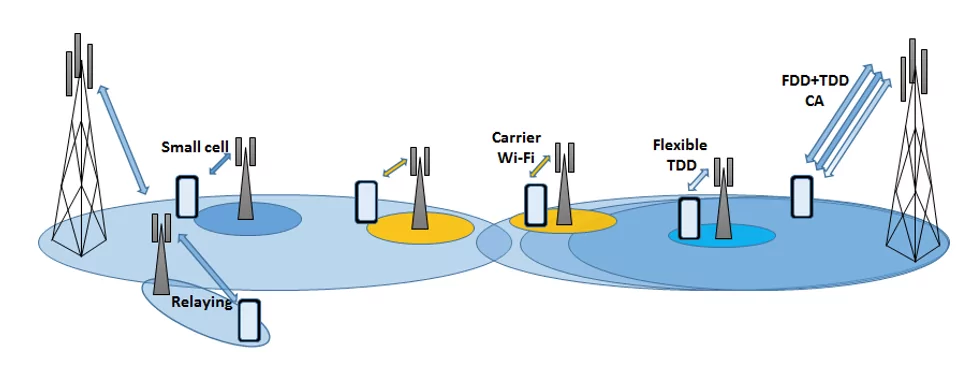Booming mobile data demand observed in cellular networks all over the world and forecasted by various studies (e.g. Cisco VNI[1]), driven by the increasingly growing availability of wide range of data-hungry mobile devices, is commonly considered as the main driver for mobile networks evolution Towards 5G. It’s not only the smartphones, tablets and/or phablets with diversified screen resolutions and device specific application mixes, but also wide range of case specific M2M / V2X devices stretching the networks towards realization of IoT, where number of connected devices will exceed number of subscribers by 10-100x.
The ever repeated thousand-fold capacity increase requirement for future mobile networks, might not be the biggest challenge to overcome in future radio access networks, as the number of challenges will grow with the increase of mobile applications diversification, device mixes, terminals penetration, etc. Impact of the mobile data demand (considered as User Plane traffic) and the underlying Control Plane signaling, should be studied in parallel to the mobile network’s architecture evolution studies. This shall allow implementation of multi-RAT, multi-band, multi-layer networks in a demand driven fashion, i.e. providing capacity and coverage where / when / if needed, in (semi)-dynamic and coordinated way, with the consideration of terminal capabilities, network load and interference situation, etc.
Continuous evolution of the mobile device capabilities, as well as the OTT apps and mobile video demand quality improvements will further push the boundaries of the mobile data demand. Therefore, the network evolution has to be well planned with future proof investments, keeping the network’s TCO on acceptable level (e.g. including energy saving issues).
Vision of the future cellular network
As we saw over the last decades, the cellular networks are continuously evolving towards multi-RAT networks, as it is not possible to easily replace RAT’s due to the legacy dependencies, support requirements on legacy terminals, regulatory requirements, etc. Continuously growing mobile data demand is forcing mobile operators to deploy additional carriers and frequency bands to cope with the increasing load and capacity demand in networks, e.g. by various Carrier Aggregation combinations. Scarce spectrum resources are motivating to look into various spectrum utilization improvements techniques, e.g. Open Carrier, Dual Connectivity, LAA, etc.
Finally, the need for improved spectral efficiency is causing the legacy networks to migrate towards HetNet’s, where new various BS classes are coexisting, creating multi-layer networks, including range of small cell nodes.
This leads to the full picture of the network which consists of:
- Multiple RATs: GSM, UMTS, HSPA, LTE/LTE-Advanced, including tight carrier Wi-Fi integration.
- Spectrum resources covering multiple frequency bands resulting in converged TDD / FDD network, equipped with various spectrum utilization mechanisms such as dynamic spectrum sharing, CA, Supplemental DL, eIMTA, or LAA/LSA.
- Spectral Efficiency improving features, such as higher order dynamic sectorization in H/V dimension, higher order MIMO, Dual Connectivity, etc.
- Multiple network layers as network densification solution: macro layer with small cell layer including pico-cells and femtocells, or CPE / home solutions.
Considering the above mentioned aspects, the overall MNO’s network has not any more the regular structure (see example below).

The overall network structure is a very complex mechanism, that shall be treated as a single heterogeneous network consisting of multiple different resource types and thus managed as a single entity instead of treating different RATs / layers separately and individually. This will be even more visible and required once the continuous evolution of the 3GPP standards will bring additional 5G-and-beyond RAT’s that will be again added on top of the legacy system leading to further multi-RAT complication.
As it was already pointed out in the background section, due to the heterogeneity of the devices and services mixes, we expect that the network is going to evolve into hybrid mechanism. Therefore “RAT-layer-application” association will be required for optimum resources utilization (e.g. LTE/LTE-A is good for high data pipes with large requirements diversification, while GSM fits as CS voice transmission if VoLTE is not available). All this is given as a conclusion of the following statement, that “one-size fits all” is no longer true. Due to this, in parallel to the spectrum refarming activities and attempts to reach one-RAT network, we rather will have to coordinate multiple RATs / layers being optimized for the specific application requirements.
RAN challenges
According to the presented future network vision, there are several aspects to be addressed in the future-proof RAN:
- we have multiple RATs with different specifics, parameters and KPIs
- the whole structure is managed by a single MNO with typically different departments
- we would like to utilize the network resources efficiently
- we would like to have a fit between RAT/layer and mobile applications
The table below present some aspects of the overall complexity of the future network vision.
| RAN management |
Multi-RAT |
HetNet |
Spectrum / SE |
| RRM |
GSM/GPRS |
DAS |
CA |
| Traffic Steering / load balancing |
UMTS/HSPA |
Pico |
CA scheduling / CC selection |
| SON (ESM / CCO / MLB / MRO) |
LTE/LTE-A |
Femto |
TDD + FDD (CA, DC) |
| OSS/OAM |
WiFi (and integration with 3GPP) |
SmallCell |
LAA/LSA |
| Common RRM |
5G radio (e.g. NOMA, Full Duplex, M-MIMO, mmWave) |
WiFi offloading |
Cognitive Radio |
| Next-G’s proof |
|
Dual Connectivity |
Supplemental DL |
| Overload control / prevention |
|
(SON-based) densification |
Spectrum sharing |
The above implies, that the overall network becomes a very complex mechanism. The typical challenges include management of the complicated HetNet and Multi-RAT network creating multidimensional optimization problems.
Note: This post is prepared with Michal Szydelko, who is the founder of Movilo Ltd. (michal.szydelko@movilo.net).
[1] Cisco Visual Network Index, www.cisco.com/c/en/us/solutions/service-provider/visual-networking-index-vni/index.html







Leave a Reply